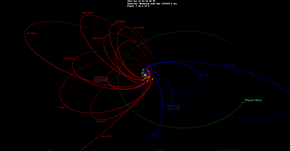2002 GB32
 2002 GB32 is seen lower right in blue with hypothetical Planet Nine in green | |
| Discovery [1] | |
|---|---|
| Discovered by | M. W. Buie [2] |
| Discovery site | Cerro Tololo Obs. |
| Discovery date | 7 April 2002 |
| Designations | |
| 2002 GB32 | |
| TNO [3] · SDO [2][4] distant [1] · detached | |
| Orbital characteristics [3] | |
| Epoch 4 September 2017 (JD 2458000.5) | |
| Uncertainty parameter 3 | |
| Observation arc | 12.96 yr (4,733 days) |
| Aphelion | 402.66 AU |
| Perihelion | 35.347 AU |
| 219.01 AU | |
| Eccentricity | 0.8386 |
| 3241.10 yr (1,183,810 days) | |
| 0.3780° | |
| 0° 0m 1.08s / day | |
| Inclination | 14.176° |
| 176.99° | |
| 37.158° | |
| Physical characteristics | |
| Dimensions | 122 km (calculated)[4] |
| 0.09 (assumed)[4] | |
| 7.8[3] | |
2002 GB32, is a trans-Neptunian object from the scattered disc in the outermost region of the Solar System, approximately 122 kilometers in diameter.[3][4] It was first observed on 7 April 2002, by American astronomer Marc Buie at Cerro Tololo Observatory in Chile.[1][2]
Description
2002 GB32 belongs to a small number of detached objects with perihelion distances of 30 AU or more, and semi-major axis of 200 AU or more.[5] Such objects can not reach such orbits without some perturbing object, which lead to the speculation of planet nine.
This minor planet orbits the Sun at a distance of 35.3–402.7 AU once every 3,241 years and 1 month (1,183,810 days). Its orbit has an eccentricity of 0.84 and an inclination of 14° with respect to the ecliptic.[3]
Based on an absolute magnitude of 7.8 and an assumed albedo of 0.09, the Johnston's Archive calculated a mean-diameter of 122 kilometers.[4]
See also
References
- ^ a b c "2002 GB32". Minor Planet Center. Retrieved 17 October 2017.
- ^ a b c "List Of Centaurs and Scattered-Disk Objects". Minor Planet Center. Retrieved 14 October 2017.
- ^ a b c d e "JPL Small-Body Database Browser: (2002 GB32)" (2015-03-23 last obs.). Jet Propulsion Laboratory. Retrieved 17 October 2017.
- ^ a b c d e "List of known Trans-Neptunian Objects". Johnston's Archive. Retrieved 14 October 2017.
- ^ minorplanetcenter.net: q>30, a>200
External links
- List Of Centaurs and Scattered-Disk Objects, Minor Planet Center
- List of known Trans-Neptunian Objects, Johnston's Archive
- 2002 GB32 at AstDyS-2, Asteroids—Dynamic Site
- 2002 GB32 at the JPL Small-Body Database
